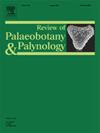四川木拉盆地早中新世云杉种子球果及其生物地理意义
IF 1.7
3区 地球科学
Q2 PALEONTOLOGY
引用次数: 0
摘要
云杉现今广泛分布于中国西南横断山区,但其巨化石记录尚不多见,这阻碍了对该地区云杉进化史的全面认识。本文对横断山中部理塘县早中新世木拉盆地保存完好的云杉种子球果化石进行了研究。这些种子球果化石的特征是:长圆形或卵形的种子球果,宽倒卵形的种子鳞片,尖裂,背面有纵条纹,苞片呈三角形-匙形。详细的形态学比较使我们确定这些标本为云杉属(Picea sp., cf. P. asperata)。这一发现表明,横断山云杉现代物种的祖先可能在中新世早期就在那里生存了,比分子系统发育的估计要早得多,后者认为它们在上新世就在那里分化了。结合之前从同一沉积物中发现的化石物种,Mula植物群代表了亚高山针叶林,与附近的现代植被相似。这表明,中新世早期横断山脉中部比现在更温暖、更湿润,与当时的全球气候条件一致。本文章由计算机程序翻译,如有差异,请以英文原文为准。
Seed cones of Picea from the early Miocene Mula Basin, Sichuan Province, southwestern China and its biogeographical implication
Picea is widely distributed in the Hengduan Mountains of southwestern China nowadays, but its megafossil records there are still rare, which prevents a full understanding of the evolutionary history of Picea in this region. In this study, we describe well-preserved fossil seed cones of Picea from the early Miocene Mula Basin in Litang County, central Hengduan Mountains. These fossil seed cones are characterized by oblong or ovate seed cones, broadly obovate seed scales with bifid apices, longitudinal striations on their abaxial surfaces, and triangular-spathulate bracts. Detailed morphological comparisons allowed us to identify these specimens as Picea sp. (cf. P. asperata). This finding implies that the ancestor of modern species for Picea in the Hengduan Mountains might have survived there by the early Miocene, much earlier than molecular phylogenetic estimates that placed their divergence there during the Pliocene. Combined with previously discovered fossil species from the same sediment, the Mula flora represents a subalpine coniferous forest, which is similar to modern vegetation nearby. It suggests that the central Hengduan Mountains were warmer and more humid during the early Miocene than today, in agreement with the global climate condition at that time.
求助全文
通过发布文献求助,成功后即可免费获取论文全文。
去求助
来源期刊
CiteScore
3.50
自引率
21.10%
发文量
149
审稿时长
6 months
期刊介绍:
The Review of Palaeobotany and Palynology is an international journal for articles in all fields of palaeobotany and palynology dealing with all groups, ranging from marine palynomorphs to higher land plants. Original contributions and comprehensive review papers should appeal to an international audience. Typical topics include but are not restricted to systematics, evolution, palaeobiology, palaeoecology, biostratigraphy, biochronology, palaeoclimatology, paleogeography, taphonomy, palaeoenvironmental reconstructions, vegetation history, and practical applications of palaeobotany and palynology, e.g. in coal and petroleum geology and archaeology. The journal especially encourages the publication of articles in which palaeobotany and palynology are applied for solving fundamental geological and biological problems as well as innovative and interdisciplinary approaches.

 求助内容:
求助内容: 应助结果提醒方式:
应助结果提醒方式:


